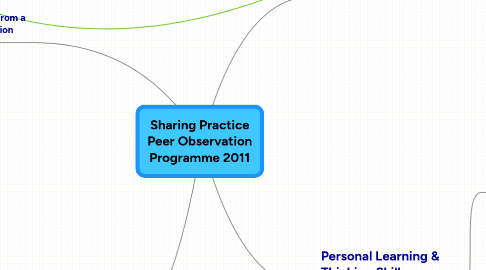
1. Teaching from a Specification
1.1. Observations
1.1.1. Varied practice, dependent on experience - a full understanding of how to use the specification can take time
1.1.2. Understanding the specification can have a significant impact on results / attainment
1.1.3. Sharing ideas both inspired and rejuvinated colleagues
1.2. Strengths & Best Practice
1.2.1. adapting to each cohort, in order to meet specification requirements
1.2.2. Creating schemes of work that are mapped to the specification criteria
1.2.3. Balancing staff strengths and expertise
1.2.4. Team work and collaboration - sharing resources, joint planning and team teaching
2. Classroom Behaviour Management
2.1. Observations
2.1.1. Shorter tasks - 'chunking' lessons, breaking them down, and pacing
2.1.2. Emphasising learner responsibility
2.1.3. seating plans
2.1.4. Clear and simple instructions
2.2. Strengths & Best Practice
2.2.1. Engaging learners in challenging, exciting and meaningful tasks / lessons
2.2.2. Empowering learners with a sense of responsibility
2.2.3. Using PLTS
3. Planning for Assessment
3.1. Observations
3.1.1. Peer assessment is a good method for sharing assessment criteria with learners
3.1.1.1. examples in PE demonstrate how level descriptors, PLTS and GCSE grade descriptions can be used to guide peer and self assessment
3.1.1.2. examples in PE of learners modelling specific skills, and meeting certain criteria
3.1.1.3. examples of peer assessment / marking in Yr13 Drama lesson where students were preparing for their written exam
3.1.2. Q&A sessions help assess pupil progress in an individual lesson, as well as across a sequence of lessons
3.1.3. Exploring learner perceptions of certain grades or grade criteria, and using exemplar work to build a picture of accurate grade descriptors
3.1.3.1. Sharing assessment criteria with learners is essential in identifying the difference between A and A*
3.2. Strenghts & Best Practice
3.2.1. Questioning as a tool for assessment
3.2.2. Peer and self assessment
4. Personal Learning & Thinking Skills
4.1. Observations
4.1.1. a whole lesson used for peer marking - reflective learning
4.1.2. PLTS made explicit, and linked to every task or phase of a lesson
4.1.3. Learners supporting and mentoring each other - team work, independent enquiry
4.2. Strengths & Best Practice
4.2.1. evaluation - self and peer
4.2.2. Independent enquiry - learners develop their own ideas, by using their own experiences
4.2.3. Team / Collaborative working - learners are used to working in teams and expectations are always set high
